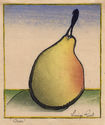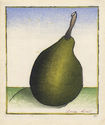
19th, 20th & 21st Century Fine Prints
707-546-7352 · fax 707-546-7924 · web: www.annexgalleries.com · email: artannex@aol.com
Luigi Rist Biography
Luigi Rist
American
1888–1959
Biography
Louis G. "Luigi" Rist was born in 1888 in Newark, New Jersey, where he attended the Newark Technical School. To earn extra income in his early twenties he etched art nouveau designs on silver fountain pen cases, and in the early 1920s he commuted to the Grand Central School of Art in New York to take courses in painting. It was here that he met Sigurd Skou, who taught painting, and Theodore “Ted” Braithwaite, an artist who later worked for the Christian Science Monitor and commissioned works from Rist; both of these artists would influence and encourage Rist throughout his career. It was also at this school that he made his first block print.
In 1929 Rist traveled with Skou to the Concarneau artist's colony in Brittany, an inspiring time for the artist who adopted the name "Luigi" after his French peers - pronouncing his name in the French manner - would address him as "Louie G." 1929 was an especially important turning point for Rist in that it also saw his introduction to Japanese woodcuts at an exhibition at Comerford Gallery in New York, which he attended at the invitation of his friend and mentor Morris Blackburn. A newfound passion was ignited, and Rist - having no one around with first-hand knowledge of the Japanese techniqe - began to teach himself the process through guesswork and close study of works in galleries and museums. He continued to guide himself until he was able to obtain a copy of Hiroshi Yoshida's Japanese Woodblock Printing, published in 1939, at which time his style rapidly progressed. These many years of autodidactic education helped him formulate the works which he would later become known for, and his marriage to Ida Weber in 1937 afforded him more time to perfect his techniques, as she opted to support the household herself to allow Rist the opportunity to be a full-time artist.
In a time when graphically strong, black-and-white printmaking was the dominant style, Rist was fortunate to be introduced to the American Color Print Society, at whose second annual exhibition he won first prize for his color woodcut "Sunflowers," in 1941. Rist's strength lay in his unique style, which combined the tonal qualities of Japanese woodcuts with Western Modernist ideals in form and composition, with influences of Cubism and Fauvism evident in his use of bold, simplified shapes. He continued to work and exhibit regularly until he and Ida purchased a farm in Vermont in 1950. The demands of daily maintenance slowed his drive to create art, and he produced on average about one print per year. Rist died on November 4, 1959 in Pennsylvania, where he was still working on the woodcuts that had fascinated him for thirty years.
Rist's prints are included in the collections of the Smithsonian, the Newark Museum, the New York Public Library, the Princeton Print Club, the Montclair Art Museum, the New Jersey State Museum, the Brooklyn Museum, the Library of Congress, the National Museum of American Art, the Butler Institute of Art, Elizabethtown College, and the Philadelphia Museum of Art, among others.
A more complete biography of Rist can be found at the San Juan Islands Museum of Art, where a large collection of his work is held.




